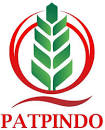EFEK LAMA PENGERINGAN TERHADAP KADAR AIR GABAH DAN MUTU BERAS KETAN
Effect of Drying Time on Grain Moisture Content and Quality of Glutinous Rice
DOI:
https://doi.org/10.36526/jipang.v4i1.2677Keywords:
drying, glutinous rice, moisture contentAbstract
Glutinous rice is one of many varieties of rice grown in Indonesia. Glutinous rice differs from other varieties due to the higher content of amylopectin. One stages of rice processing that determines the quality characteristics of the rice is drying process. This process can be carried out directly under the sun or under the shade on the drying floor. Otherwise drying process also can be carried out in silo’s by utilizing wind gust to reduce the moisture content or the grain. In this study, the grain was dried on a drying floor using a tarp as a base for about 3, 4, 5, 6 and 7 days. The results showed that the grain which was dried for 3 to 4 days had a moisture content of 14%, the longer the grain dried, the water content of the grain will increase about 1-2%. The quality of the grain treated with the variation in drying time, showed that the longer drying time, the lower of whole rice produced and the more broken rice produced. Drying process in 3-4 days shows the percentage of broken rice and very small broken rice is about 21-22% and 1.6 until 1%. While drying at 5-7 days show the percentage of broken rice and very small broken rice is 24-27% and 1.3 until 7.1.
References
BSN. 2015. Standar Nasional Indonesia 6128: 2015 tentang Beras. Badan Standardisasi Nasional. Jakarta
Budi M.K. 2015. Hubungan Kadar Air Gabah Dengan Mutu Beras Giling Varietas Unggul Di Kabupaten Tanah Bumbu Kalimantan Selatan. UNLAM. Banjarbaru.
Daud, Ahmad. Suriati, Nuzulyanti. 2019. Kajian Penerapan Faktor yang Mempengaruhi Akurasi Penentuan Kadar Air Metode Thermogravimetri. Jurnal Lutjanus. 24 (2): 11-16 https://doi.org/10.51978/jlpp.v24i2.79
H.D Jhon, Kartinaty T. 2019. Karakteristik Mutu Beras di berbagai Sentra Padi di Kalimantan Barat. Journal Tabaro. Vol 3(1): 276-286.
Hanas, D.F., E. Kriswiyanti, I. Ketut. 2017. Karakter morfologi beras sebagai pembeda varietas padi. Journal Leg. Forensic Science. 1:23-28.
KEMENTAN. 2019. Optimis Produksi Beras 2018, Kementan Pastikan Harga Beras Stabil. Dapat diakses https://www.pertanian.go.id/home/?show=news&act=view&id=2614
Listyawati. 2007. Kajian Susut Pasca Panen dan Pengaruh Kadar Air Gabah Terhadap Mutu Beras Giling Varietas Ciherang (Studi Kasus di Kecamatan Tegalsari Kabupaten Karawang). [Skripsi]. Fakultas Teknologi Pertanian.Institut Pertanian Bogor: Bogor.
Sepian B. 2016. Pengaruh Kadar Air Gabah dan Kelembapan Simpan Terhadap Perubahan Mutu Beras Giling. [Skripsi]. Fakultas Pertanian. Universitas Sriwijaya.
Syahrul, Mirmanto, Ramdoni S. 2017. Pengaruh Kecepatan Udara dan Massa gabah Terhadap kecepatan Pengeringan Gabah Menggunakan Pengering Terfluidasi. Jurnal Dinamika Teknik Mesin. Vol 7(1): 54-59.
Ulfa R, Hariyadi P, Muhandri T. 2014. Rendemen Giling dan Mutu Beras Pada Beberapa Unit Penggilingan Padi Kecil Keliling di Kabupaten Banyuwangi. Jurnal Mutu Pangan. 1(1), 26-32.











